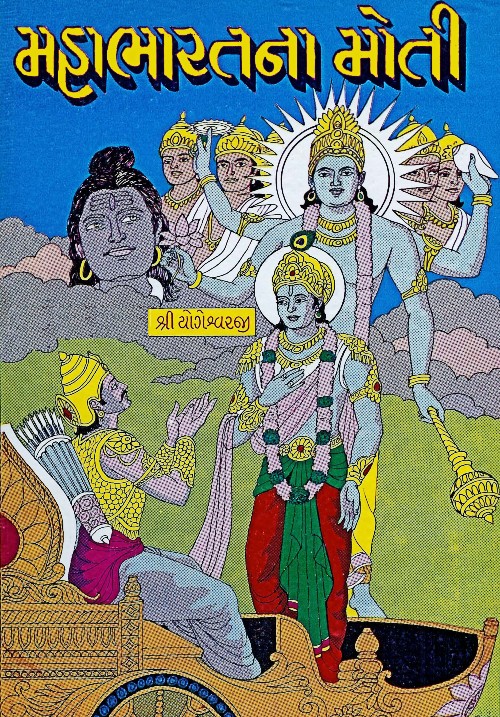 Mahabharat, which literally means ‘the great story of Bharat dynasty’ is part of the Hindu Itihās, i.e. ‘that which happened’. It is an extraordinary story of sibling rivalry, diplomatic maneuvering and shifting of human values culminating in a direct confrontation on the battlefield of Kurukshetra between five sons of King Pandu (Pandavas) and hundred sons of King Dhritarastra (Kauravas). It's a tale of tragic war which pitted brothers against brothers, sons against fathers and students against teachers. Exceptional characters, in-depth and complex set of interwoven relationships and dramatization on a grand scale makes this epic a memorable one. It's also a saga which marks the end of an era (dvapar Yuga) wherein characters lived up to morals, values and principles to the beginning of an era (Kali Yuga), wherein selfishness, deceit and immorality rules the reins.
Mahabharat, which literally means ‘the great story of Bharat dynasty’ is part of the Hindu Itihās, i.e. ‘that which happened’. It is an extraordinary story of sibling rivalry, diplomatic maneuvering and shifting of human values culminating in a direct confrontation on the battlefield of Kurukshetra between five sons of King Pandu (Pandavas) and hundred sons of King Dhritarastra (Kauravas). It's a tale of tragic war which pitted brothers against brothers, sons against fathers and students against teachers. Exceptional characters, in-depth and complex set of interwoven relationships and dramatization on a grand scale makes this epic a memorable one. It's also a saga which marks the end of an era (dvapar Yuga) wherein characters lived up to morals, values and principles to the beginning of an era (Kali Yuga), wherein selfishness, deceit and immorality rules the reins.
Besides compelling drama and riveting plot, Mahabharata is unique in many ways. Larger than life characters including that of Lord Krishna, considered as an incarnation of Lord Vishnu; Bhisma - great grandfather of principle warriors, who pledged to serve the kingdom of Hastinapur and ended up being a silent witness of its fall; Arjuna - unparalleled archer of that time, who laid down his arms at the beginning of the war; Karna - son of Kunti who ended up on the enemy camp due to misfortune; Yudhisthir - an icon of truth who was compelled to lie to win over the battle; Duryodhan - son of blind king whose unending ambitions became the root cause of trouble; Dronacharya - accomplished teacher of that time, who was forced to fight against his favorite student Arjuna...all make this epic spectacular and fascinating.
Download મહાભારતના મોતી (Gujarati) in PDF
Every single incident of Mahabharata is full of twists and turns - whether be it the game of dice between brothers or be it the 13 years exile of Pandavas in the forest with a condition of anonymity for the last year, or be it a mysterious fire in the house of wax and Pandava's miraculous escape thereof or be it the laying down of arms by dishearten Arjuna in the battlefield, which resulted in delivery of the message of Bhagavad-Gita (song of the supreme) by Lord Krishna or be it the deftness of Krishna in navigating Pandavas to victory and beyond. In a way, Ramayana and Mahabharata form the very basis of cultural consciousness that symbolize Hinduism. It's not a surprise that Mahabharata has attracted tremendous interest among literates and common man alike of India or East Asia but pundits and philosophers all over the world.
Download Mahabharat (Original Sanskrit) Text in PDF
A timeless creation of Sage Ved Vyasa (who himself is one of the character of this epic) and one of the longest poem of all times, Mahabharata is divided into eighteen books or chapters (called Parvas) namely
- Shalya Parva (शल्य पर्व)
- Stri Parva (स्त्री पर्व)
- Anushashana Parva (अनुशासन पर्व)
- Ashvameghadik Parva (आश्वमेधिक पर्व)
- Ashramvasik Parva (आश्रमवासिक पर्व)
- Musala Parva (मौसल पर्व)
- Mahaprasthanika Parva (महाप्रस्थानिक पर्व)
- Swargarohan Parva (स्वर्गारोहण पर्व)
It is interesting to note that Bhagavad-Gita, most sacred text of Hindus having great philosophical impact, is part of Mahabharata (Bhishma Parva). Similarly, Vishnu Sahasranama, the most famous hymn of Lord Vishnu containing thousand names of the Supreme is part of Anusashana Parva. Other principal stories that are part of Mahabharata includes the life and works of Lord Krishna (Krishnavatar) woven throughout various chapters of Mahabharata, the love story of Nala and Damayanti as well as an abbreviated Ramayana in Aranyak Parva.
Shri Yogeshwarji, extraordinary Gujarati poet and literate of modern times, wrote a voluminous treatise on Mahabharata entitled 'Mahabharat Na Moti' (pearls of Mahabharata) in which he elaborated on principal stories of Mahabharata in simplified Gujarati language. Through the medium of this web site, it is our humble endeavor to make this grand epic available to ubiquitous Gujarati people. We earnestly wish that it will help pass on the great message of Mahabharata to our coming generations. Your responses on this offering are most welcome.

